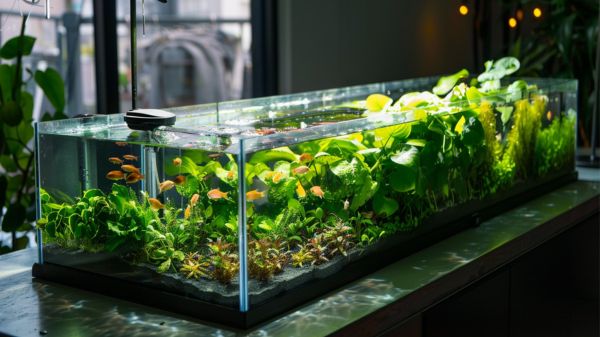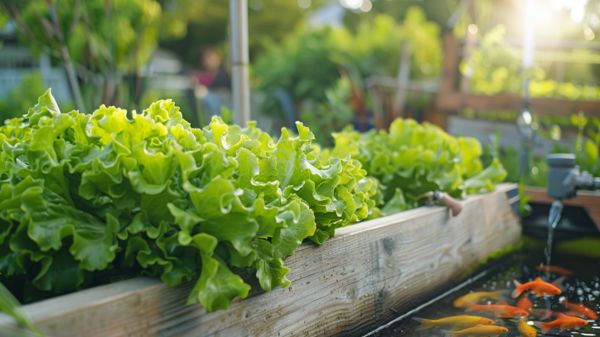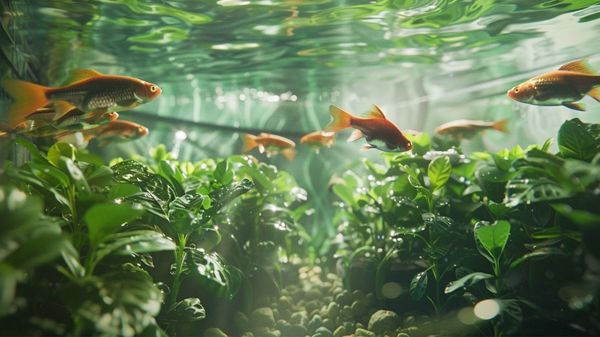Designing an efficient aquaponics system requires careful planning and strategic implementation. Let’s explore the best efficient best aquaponics system design tips from experts in this field that you can possibly use to start your project.
Key elements such as layout design, tank placement, and sunlight enhancement play crucial roles in achieving top-notch growth conditions for both plants and fish. By situating grow beds to maximize sunlight and positioning fish tanks strategically to maintain stable temperatures, one can significantly improve productivity.
Additionally, integrating passive solar greenhouses and vertical growing systems can further optimize space utilization. However, to ensure the system’s uninterrupted operation, precise electrical planning and effective heating strategies are essential. Curious about the best practices that can elevate your aquaponics system to the next level?
Key Takeaways
- Position grow beds in sunlit areas and fish tanks in shaded areas for optimal temperature control.
- Use vertical growing systems to maximize space and sunlight exposure.
- Insulate greenhouses to maintain stable temperatures and protect root systems.
- Plan electrical needs accurately and consult an electrician to prevent system overloads.
- Choose hardier fish species to minimize heating requirements and ensure system efficiency.
Design and Layout
When designing an efficient aquaponics system, a strategic layout that optimizes sunlight exposure and temperature regulation is crucial for maximizing plant growth and fish health. The placement of grow beds and fish tanks requires careful consideration; grow beds should be positioned in areas with maximum sunlight exposure to promote photosynthesis, while fish tanks should be situated in shadier sections to help regulate water temperature.
Incorporating passive solar greenhouses can further optimize sunlight exposure, leveraging natural light and heat to maintain ideal growing conditions. Vertical growing systems are a practical solution to maximize production in limited spaces, allowing for layers of grow beds that capitalize on available vertical space without compromising sunlight access.
Ensuring efficient access to water heaters and essential equipment is paramount in the greenhouse layout. This includes strategically placing these elements to facilitate ease of maintenance and operation.
Flooring materials like concrete, gravel, pavers, stone, or dirt should be chosen based on their durability, maintenance requirements, and cost-effectiveness. Protecting root systems from extreme temperatures is crucial; therefore, the choice of flooring materials also plays a role in maintaining stable ground temperatures.
An optimized design and layout enhance the overall productivity and sustainability of the aquaponics system.
Related Post: Top DIY Aquaponics System Design Plans.
Tank Placement
Proper tank positioning is vital for maintaining stable water temperatures and guaranteeing efficient system maintenance in an aquaponics setup. Strategic placement of fish tanks, grow beds, and sump tanks within the greenhouse environment can greatly impact the overall effectiveness and productivity of the system.
You should situate the fish tanks should in shadier areas of the greenhouse to prevent excessive water temperature fluctuations, which can strain aquatic life. Grow beds, conversely, should be positioned to maximize sunlight exposure, promoting strong plant growth and photosynthesis. Sump tanks, essential for water circulation and nutrient distribution, must be easily reachable for regular maintenance.
An effective layout often utilizes above-ground tanks for their visibility and ease of access. In addition, meticulous planning is necessary to guarantee the tanks are conveniently positioned near heating and electrical sources, enabling efficient energy use and system control. Below is a table summarizing best tank placements:
| Component | Positioning Considerations |
|---|---|
| Fish Tanks | Shadier areas for maintaining water temperatures |
| Grow Beds | Sunlit areas for optimal photosynthesis |
| Sump Tanks | Easily reachable for maintenance |
| Above-Ground Tanks | Enhanced visibility and accessibility |
Sunlight Optimization
Maximizing sunshine exposure is crucial for enhancing plant growth and overall system productivity in aquaponics setups. To achieve best sunlight optimization, it is critical to place grow beds in direct sunshine, guaranteeing plants receive the necessary light for robust growth and increased productivity.
Conversely, you should position the fish tanks in shaded areas to prevent overheating, thereby reducing stress on the fish and maintaining a balanced ecosystem.
Utilizing passive solar greenhouses can greatly improve sunshine exposure for both plants and fish. These structures capture and retain solar energy, creating a controlled environment that fosters efficient use of sunshine.
Implementing vertical growing systems can further maximize space and sunshine exposure, enabling plants to receive uniform light distribution from all angles.
Proper insulation is paramount for protecting root systems from extreme temperatures. Efficient insulation techniques, combined with strategic sunshine exposure, ensure that plants and fish thrive in a stable environment.
Related Post: 8 Best Indoor Aquaponics Fish Tank Systems for Sustainable Home Gardening.
Electrical Planning
Accurate electrical planning is necessary for guaranteeing the uninterrupted operation and efficiency of an aquaponics system. Begin by determining the power needs of your aquaponics equipment, which typically includes water and air pumps, lighting fixtures, and heating systems. Evaluating these requirements allows for a thorough understanding of the total power draw, which is vital to prevent system overload.
Consulting with an electrician can offer invaluable insights into proper wiring and the incorporation of energy-efficient options. This not only guarantees safety but also promotes long-term savings.
Strategically placing extra outlets throughout the greenhouse is a practical measure to accommodate current and future electrical requirements, providing flexibility for unexpected expansions or modifications.
Adequate ventilation is another aspect to take into account in your electrical planning. Proper ventilation systems help maintain ideal conditions for both fish and plants, thereby enhancing overall system performance. When planning for heating systems, make sure they are compatible with your electrical setup to avoid any disruptions.
Heating Strategies
Effective heating strategies are necessary for maintaining ideal temperatures in aquaponics systems, thereby ensuring both plant and fish health while minimizing energy consumption. To achieve this, insulating the greenhouse is essential. Proper insulation helps maintain stable air and water temperatures, significantly reducing heating costs and overall energy consumption.
For systems located in colder climates, opting for hardier fish species can minimize heating requirements without compromising optimal fish health. These species adapt better to lower temperatures, thereby reducing the need for extensive heating solutions.
Implementing Ground to Air Heat Transfer (GAHT) systems can further enhance temperature regulation by leveraging ground temperature stability, thus optimizing energy usage. GAHT systems circulate air through underground pipes, using the earth’s consistent temperature to warm or cool the air, which is then reintroduced into the greenhouse.
Moreover, preventing overheating is vital for maintaining dissolved oxygen levels, which are crucial for fish health. Covering tanks to shield them from direct sunlight can prevent excessive warming and algae growth, thereby preserving water quality.
Conclusion
Strategic design and layout play a crucial role in optimizing aquaponics systems by ensuring maximum sunlight exposure and stable water temperatures. Effective tank placement, coupled with the utilization of passive solar greenhouses and vertical growing systems, enhances production in limited spaces.
Thorough electrical planning, along with strong insulation and heating strategies, is essential for maintaining uninterrupted system operation and the health of both plants and fish. Implementing these measures fosters efficient, sustainable aquaponics systems.




